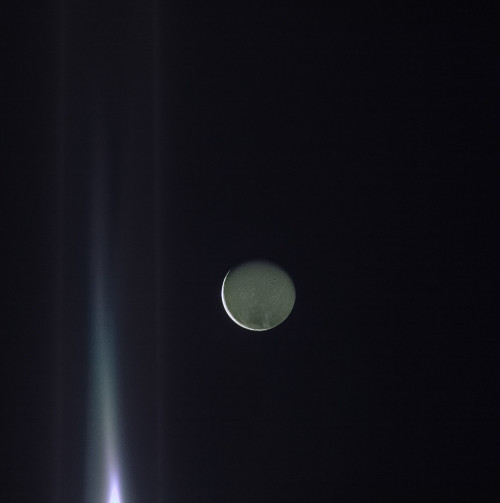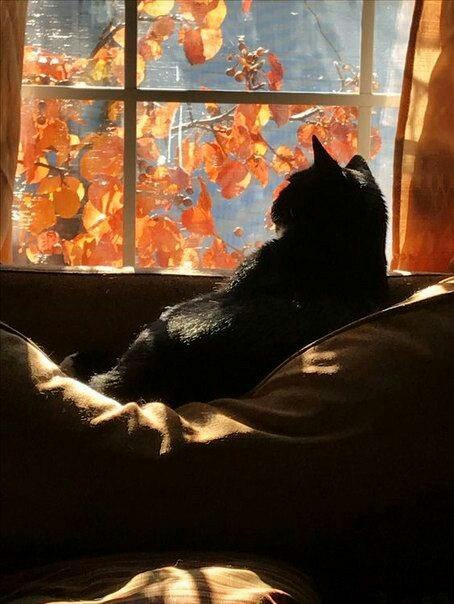🐈🍁🍂
🐈🍁🍂

via Fall/Halloween
••• Wake Me Up When September Starts •••
More Posts from Monstrous-mind and Others

The View Toward M101 : Big, beautiful spiral galaxy M101 is one of the last entries in Charles Messier’s famous catalog, but definitely not one of the least. About 170,000 light-years across, this galaxy is enormous, almost twice the size of our own Milky Way galaxy. M101 was also one of the original spiral nebulae observed by Lord Rosse’s large 19th century telescope, the Leviathan of Parsontown. M101 shares this modern telescopic field of view with spiky foreground stars within the Milky Way and a companion dwarf galaxy NGC 5474 (lower right). The colors of the Milky Way stars can also be found in the starlight from the large island universe. Its core is dominated by light from cool yellowish stars. Along its grand design spiral arms are the blue colors of hotter, young stars mixed with obscuring dust lanes and pinkish star forming regions. Also known as the Pinwheel Galaxy, M101 lies within the boundaries of the northern constellation Ursa Major, about 23 million light-years away. NGC 5474 has likely been distorted by its past gravitational interactions with the dominant M101. via NASA

The Instrument Deployment Camera (IDC), located on the robotic arm of NASA’s InSight lander, took this picture of the Martian surface on Nov. 26, 2018, the same day the spacecraft touched down on the Red Planet. The camera’s transparent dust cover is still on in this image, to prevent particulates kicked up during landing from settling on the camera’s lens. This image was relayed from InSight to Earth via NASA’s Odyssey spacecraft, currently orbiting Mars.
Credits: NASA/JPL-Caltech
🔭🌌


Dione (moon of Saturn) 2005 and 2015
Credit: NASA/JPL-Caltech/SSI/Kevin M. Gill
🎃🍁🍂🐈🐾🍂🍁🎃

🍃🍁🍂🎃🍂🍁

🔭🌃🌌🐈

Located over 50 million light years away, the large, distorted spiral NGC 1532 is seen locked in a gravitational struggle with dwarf galaxy NGC 1531 (right of center), a struggle the smaller galaxy will eventually lose.
Image Credit: Michel Meunier, Laurent Bernasconi, Janus Team
🍁🍂🎃

10 Things: Calling All Pluto Lovers
June 22 marks the 40th anniversary of Charon’s discovery—the dwarf planet Pluto’s largest and first known moon. While the definition of a planet is the subject of vigorous scientific debate, this dwarf planet is a fascinating world to explore. Get to know Pluto’s beautiful, fascinating companion this week.
1. A Happy Accident

Astronomers James Christy and Robert Harrington weren’t even looking for satellites of Pluto when they discovered Charon in June 1978 at the U.S. Naval Observatory Flagstaff Station in Arizona – only about six miles from where Pluto was discovered at Lowell Observatory. Instead, they were trying to refine Pluto’s orbit around the Sun when sharp-eyed Christy noticed images of Pluto were strangely elongated; a blob seemed to move around Pluto.
The direction of elongation cycled back and forth over 6.39 days―the same as Pluto’s rotation period. Searching through their archives of Pluto images taken years before, Christy then found more cases where Pluto appeared elongated. Additional images confirmed he had discovered the first known moon of Pluto.
2. Forever and Always

Christy proposed the name Charon after the mythological ferryman who carried souls across the river Acheron, one of the five mythical rivers that surrounded Pluto’s underworld. But Christy also chose it for a more personal reason: The first four letters matched the name of his wife, Charlene. (Cue the collective sigh.)
3. Big Little Moon

Charon—the largest of Pluto’s five moons and approximately the size of Texas—is almost half the size of Pluto itself. The little moon is so big that Pluto and Charon are sometimes referred to as a double dwarf planet system. The distance between them is 12,200 miles (19,640 kilometers).
4. A Colorful and Violent History

Many scientists on the New Horizons mission expected Charon to be a monotonous, crater-battered world; instead, they found a landscape covered with mountains, canyons, landslides, surface-color variations and more. High-resolution images of the Pluto-facing hemisphere of Charon, taken by New Horizons as the spacecraft sped through the Pluto system on July 14 and transmitted to Earth on Sept. 21, reveal details of a belt of fractures and canyons just north of the moon’s equator.
5. Grander Canyon

This great canyon system stretches more than 1,000 miles (1,600 kilometers) across the entire face of Charon and likely around onto Charon’s far side. Four times as long as the Grand Canyon, and twice as deep in places, these faults and canyons indicate a titanic geological upheaval in Charon’s past.
6. Officially Official

In April 2018, the International Astronomical Union—the internationally recognized authority for naming celestial bodies and their surface features—approved a dozen names for Charon’s features proposed by our New Horizons mission team. Many of the names focus on the literature and mythology of exploration.
7. Flying Over Charon
This flyover video of Charon was created thanks to images from our New Horizons spacecraft. The “flight” starts with the informally named Mordor (dark) region near Charon’s north pole. Then the camera moves south to a vast chasm, descending to just 40 miles (60 kilometers) above the surface to fly through the canyon system.
8. Strikingly Different Worlds

This composite of enhanced color images of Pluto (lower right) and Charon (upper left), was taken by New Horizons as it passed through the Pluto system on July 14, 2015. This image highlights the striking differences between Pluto and Charon. The color and brightness of both Pluto and Charon have been processed identically to allow direct comparison of their surface properties, and to highlight the similarity between Charon’s polar red terrain and Pluto’s equatorial red terrain.
9. Quality Facetime

Charon neither rises nor sets, but hovers over the same spot on Pluto’s surface, and the same side of Charon always faces Pluto―a phenomenon called mutual tidal locking.
10. Shine On, Charon

Bathed in “Plutoshine,” this image from New Horizons shows the night side of Charon against a star field lit by faint, reflected light from Pluto itself on July 15, 2015.
Read the full version of this week’s ‘10 Things to Know’ article on the web HERE.
Make sure to follow us on Tumblr for your regular dose of space: http://nasa.tumblr.com.
Ten interesting facts about Jupiter
Here is a list of some interesting facts about the planet Jupiter. A planet that catches the attention of all, by its size, storms and its surprising moons.

The mass of Jupiter is 318 times as massive as the Earth. In fact, Jupiter is 2.5 times more massive than all of the other planets in the Solar System combined.

Its gravity is so strong that a rocket would have to go an unthinkable 135,000 mph to leave.

The Great Red Spot on Jupiter is one of its most familiar features. This persistent anticyclonic storm, which is located south of its equator, measures between 24,000 km in diameter and 12–14,000 km in height. As such, it is large enough to contain two or three planets the size of Earth’s diameter. And the spot has been around for at least 350 years, since it was spotted as far back as the 17th century.

Jupiter’s rings were discovered in 1979 by the passing Voyager 1 spacecraft, but their origin was a mystery. Data from the Galileo spacecraft that orbited Jupiter from 1995 to 2003 later confirmed that these rings were created by meteoroid impacts on small nearby moons.

Extending up to seven million kilometers in the Sun’s direction and almost to the orbit of Saturn in the opposite direction, Jupiter’s magnetosphere is the largest and most powerful of any planetary magnetosphere in the Solar System, and by volume the largest known continuous structure in the Solar System after the heliosphere.

Jupiter has a total of 69 natural satellites. The four largest are: Io, Europa, Ganymede and Callisto. However, it is estimated that the planet has over 200 natural satellites orbiting it. Almost all of them are less than 10 kilometers in diameter, and were only discovered after 1975, when the first spacecraft (Pioneer 10) arrived at Jupiter.

Jupiter Has Been Visited 8 Times By Spacecraft. Jupiter was first visited by NASA’s Pioneer 10 spacecraft in December 1973, and then Pioneer 11 in December 1974. Then came the Voyager 1 and 2 flybys, both of which happened in 1979. This was followed by a long break until Ulysses arrived in February 1992, followed by the Galileo space probe in 1995. Then Cassini made a flyby in 2000, on its way to Saturn. And finally, NASA’s New Horizons spacecraft made its flyby in 2007. NASA’s Juno spacecraft is currently orbiting Jupiter.

Jupiter is the third brightest object in the Solar System, after Venus and the Moon.

Jupiter Is The Fastest Spinning Planet In The Solar System. For all its size and mass, Jupiter sure moves quickly. In fact, with an rotational velocity of 12.6 km/s (~7.45 m/s) or 45,300 km/h (28,148 mph), the planet only takes about 10 hours to complete a full rotation on its axis. And because it’s spinning so rapidly, the planet has flattened out at the poles a little and is bulging at its equator.

Jupiter Cannot Become A Star. Astronomers call Jupiter a failed star, but that’s not really an appropriate description. While it is true that, like a star, Jupiter is rich in hydrogen and helium, Jupiter does not have nearly enough mass to trigger a fusion reaction in its core. This is how stars generate energy, by fusing hydrogen atoms together under extreme heat and pressure to create helium, releasing light and heat in the process.
This is made possible by their enormous gravity. For Jupiter to ignite a nuclear fusion process and become a star, it would need more than 70 times its current mass. If you could crash dozens of Jupiters together, you might have a chance to make a new star. But in the meantime, Jupiter shall remain a large gas giant with no hopes of becoming a star. Sorry, Jupiter!
Sources: universetoday and wikipedia
Images credits: Wikimedia Commons, JAXA, NASA, ESA, Hubble, Wang Letian & Michael Carroll
-
 leftmyheartinlondon liked this · 1 year ago
leftmyheartinlondon liked this · 1 year ago -
 yolieliz liked this · 2 years ago
yolieliz liked this · 2 years ago -
 jukeboxofjellycat reblogged this · 2 years ago
jukeboxofjellycat reblogged this · 2 years ago -
 eretria liked this · 4 years ago
eretria liked this · 4 years ago -
 artemisbarnowl liked this · 4 years ago
artemisbarnowl liked this · 4 years ago -
 brittomartis reblogged this · 4 years ago
brittomartis reblogged this · 4 years ago -
 the-autumn-coloured-world reblogged this · 4 years ago
the-autumn-coloured-world reblogged this · 4 years ago -
 littlegoldenleaf reblogged this · 5 years ago
littlegoldenleaf reblogged this · 5 years ago -
 littlegoldenleaf liked this · 5 years ago
littlegoldenleaf liked this · 5 years ago -
 mimseysomeday liked this · 5 years ago
mimseysomeday liked this · 5 years ago -
 xxnot-an-illusionxx liked this · 5 years ago
xxnot-an-illusionxx liked this · 5 years ago -
 deepautumncolors reblogged this · 5 years ago
deepautumncolors reblogged this · 5 years ago -
 catbeloved reblogged this · 5 years ago
catbeloved reblogged this · 5 years ago -
 autumnwishes10 reblogged this · 5 years ago
autumnwishes10 reblogged this · 5 years ago -
 jaded-scorpio reblogged this · 5 years ago
jaded-scorpio reblogged this · 5 years ago -
 piscesgal1954 reblogged this · 5 years ago
piscesgal1954 reblogged this · 5 years ago -
 muqueeen liked this · 5 years ago
muqueeen liked this · 5 years ago -
 brenda-celine reblogged this · 5 years ago
brenda-celine reblogged this · 5 years ago -
 brenda-celine liked this · 5 years ago
brenda-celine liked this · 5 years ago -
 adoring-autumn reblogged this · 5 years ago
adoring-autumn reblogged this · 5 years ago -
 tiredseasons-blog reblogged this · 5 years ago
tiredseasons-blog reblogged this · 5 years ago -
 sadautumngirl reblogged this · 5 years ago
sadautumngirl reblogged this · 5 years ago -
 itill--do reblogged this · 5 years ago
itill--do reblogged this · 5 years ago -
 bunnyemily liked this · 5 years ago
bunnyemily liked this · 5 years ago -
 protectedbymedusa reblogged this · 5 years ago
protectedbymedusa reblogged this · 5 years ago -
 protectedbymedusa liked this · 5 years ago
protectedbymedusa liked this · 5 years ago -
 westofwonder reblogged this · 5 years ago
westofwonder reblogged this · 5 years ago -
 deerling-beloved liked this · 5 years ago
deerling-beloved liked this · 5 years ago -
 kickedoxygen reblogged this · 5 years ago
kickedoxygen reblogged this · 5 years ago -
 eve-made-the-right-choice reblogged this · 5 years ago
eve-made-the-right-choice reblogged this · 5 years ago -
 eve-made-the-right-choice liked this · 5 years ago
eve-made-the-right-choice liked this · 5 years ago -
 autumnlights reblogged this · 5 years ago
autumnlights reblogged this · 5 years ago -
 cal-y-pso reblogged this · 5 years ago
cal-y-pso reblogged this · 5 years ago -
 yorherr liked this · 5 years ago
yorherr liked this · 5 years ago -
 momsthetic reblogged this · 5 years ago
momsthetic reblogged this · 5 years ago -
 porcoboia66 liked this · 5 years ago
porcoboia66 liked this · 5 years ago -
 aqueenandastar liked this · 5 years ago
aqueenandastar liked this · 5 years ago -
 herehasabitofeverything reblogged this · 5 years ago
herehasabitofeverything reblogged this · 5 years ago -
 omeu1995 reblogged this · 5 years ago
omeu1995 reblogged this · 5 years ago
My ambition is handicapped by laziness. -C. Bukowski Me gustan las personas desesperadas con mentes rotas y destinos rotos. Están llenos de sorpresas y explosiones. -C. Bukowski. I love cats. Born in the early 80's, raised in the 90's. I like Nature, Autumn, books, landscapes, cold days, cloudy Windy days, space, Science, Paleontology, Biology, Astronomy, History, Social Sciences, Drawing, spending the night watching at the stars, Rick & Morty. I'm a lazy ass.
222 posts